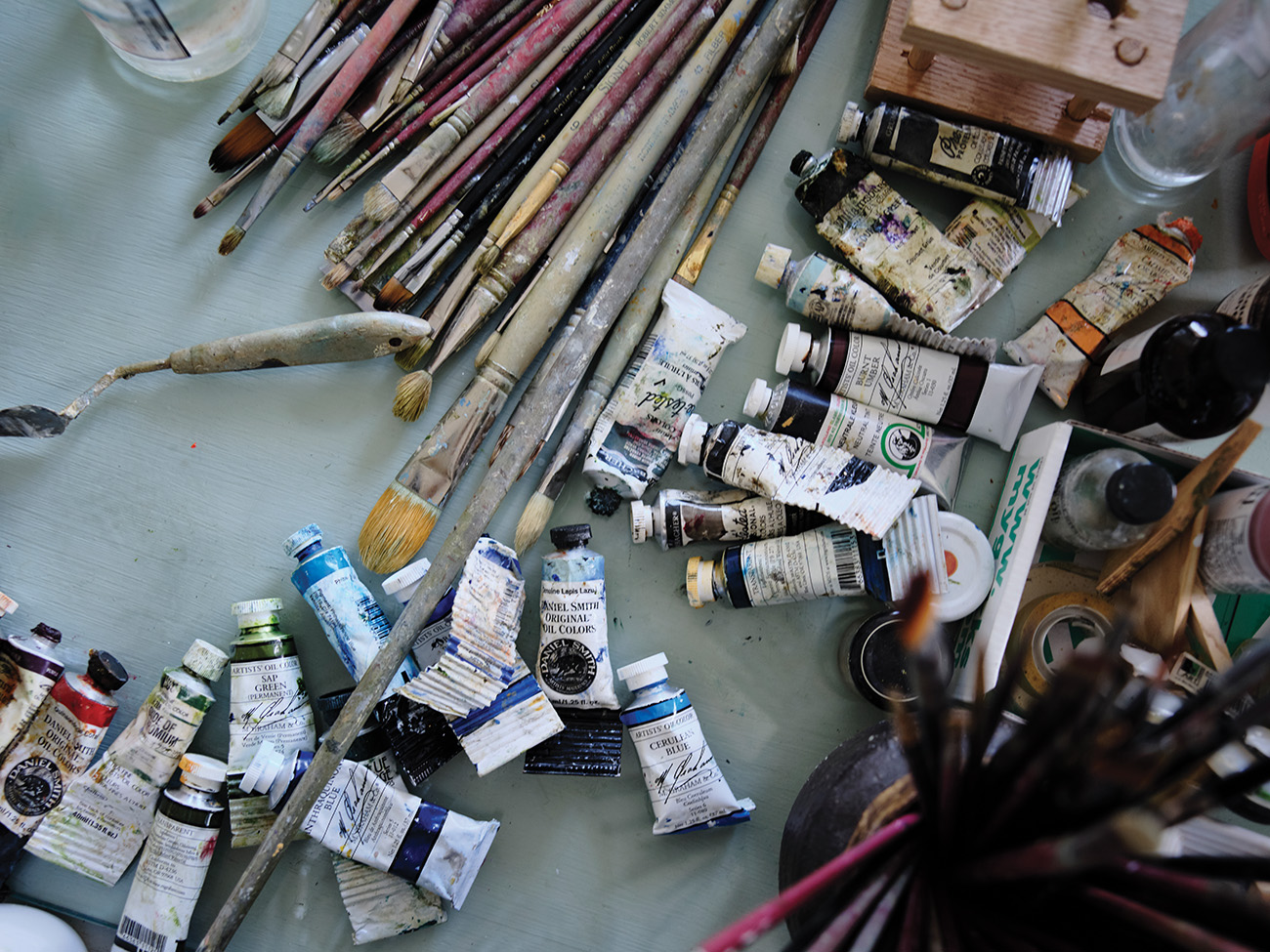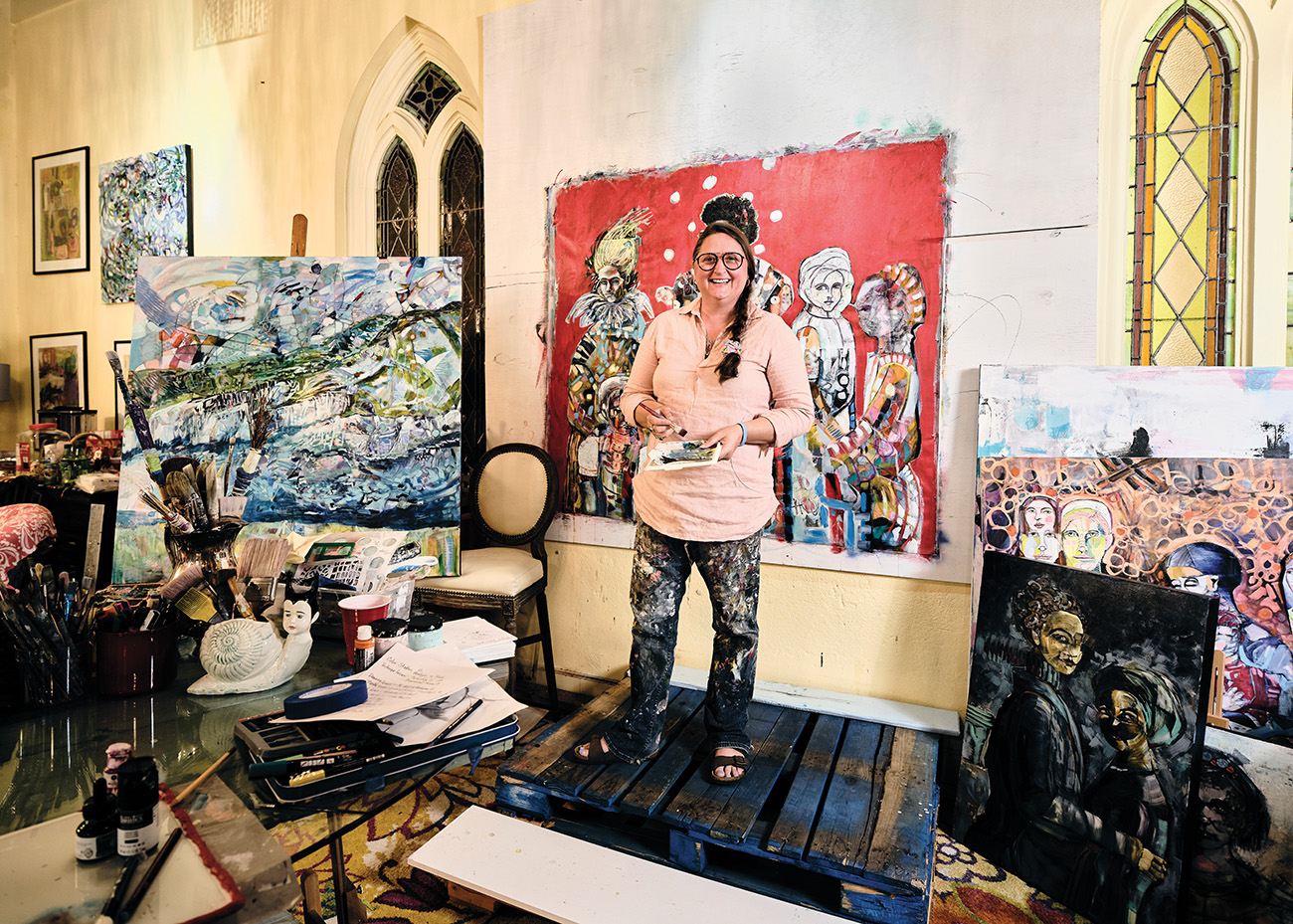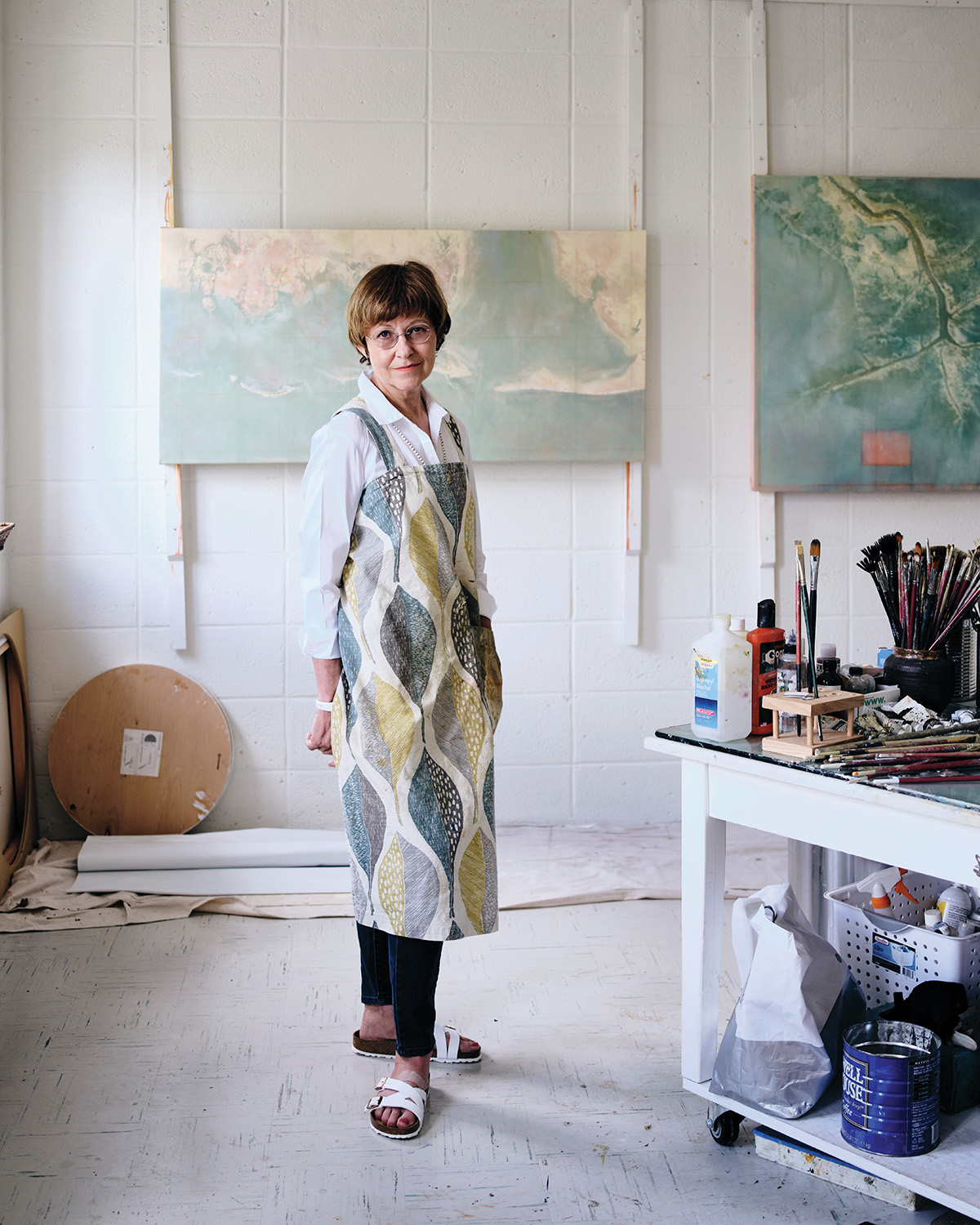
Admittedly, I am curious and a touch nervous this morning. Standing outside the nondescript three-story building at Central Presbyterian Church, I press the buzzer and wait. “May I help you?” queries a sugar-sweet voice from the box mounted on the brick wall. I tell her I am there to interview artists.
That is the short answer. Really, I am here to peek inside the world of artists, all of whom rent studio space at the church as part of Central Arts Collective (CAC). But I have to go further than a few feet inside the entryway to see if my visions of paint-splattered floors and charcoal-smeared aprons are correct, as the closed classroom-like doors reveal nothing of the mystery behind them.

The Base Coat
What is it about artists’ studios that make them so intriguing? Perhaps it’s the perplexing puzzle of how someone could enter a room with a vision in mind and exit with a masterpiece in hand. What goes on behind the scenes, exactly?
This fascination traces back to the Renaissance, the root of artist studios. What began as a place where master artists taught apprentices melded over time into a workplace-gallery, with patrons invited in to watch artists as well as admire their finished pieces. But like watercolors on a palette, the function of studios has remained fluid through the centuries, even within the modern-day CAC, a little-known community of artists in the heart of Midtown.
Unlike a traditional collective, where artists work collaboratively to produce and sell art together as a group, each artist within the CAC creates his or her own form of art and manages business independently. In 2016, Central Presbyterian began renting unused spaces, like old Sunday school classrooms, the former chapel and the church’s old parlor, to artists as a way to connect with the community.
“We were searching for ways to make good use of this lovely old building,” the Rev. Chris Bullock says. In turn, artists pay a nominal monthly rent and the church uses those funds for utilities, repairs and renovations, and community projects. But it’s something less tangible that might mean the most. “I am amazed at how generously the CAC works in the community,” Bullock continues.

Brush Strokes
“Community” is a word that is used a lot around the CAC, I think to myself, as I wind through the maze-like layout. On my way to the third floor, up a stairwell painted with inspirational sayings, I hit a literal dead end. (I later discovered I was only on floor two and a half; I had taken the wrong stairwell.)
As I backtrack down the darkened hallway, light spills from a square-shaped window and pools in front of a closed door. Inside I spy Cat Pope, her blonde bob catching my eye, as well as her open and airy room. Although she’s only been in her studio for two weeks, the walls are dappled with some of her favorite pieces, and she’s already begun assembling drying racks and storage cabinets.
She grins after I reveal my goal of demystifying what happens within these four walls. “There’s a mystery and novelty behind the artist’s studio,” Pope laughs, “which I think is silly because it’s just a place I go to make a mess.” The purpose of her hard-to-come-by space is not all about making a mess, however. “Painting can be very solitary,” she says of time spent in her home studio. “I was on the waiting list [at CAC] for a while. Somebody moved out, and I moved in. I’m thankful for the community that I have built here.”
Part of Pope’s network includes Lisa Warren, who, if I were in charge of assigning titles, would be named mayor of the CAC — she knows just about everyone and everything, it seems, which is helpful to this wayward investigator. Warren’s outgoing confidence and positivity is contagious, and one eye sweep across her parlor-turned-studio reveals drawings, paintings, pottery and a memory board full of family photographs. “It’s like a home away from home,” she says of her first-floor studio. “This space gives me a destination, a focus.”
Sunlight through the stained glass windows in Warren’s studio casts a glow across the unfinished concrete floor, mirroring the warmth of her voice as she shares what the CAC has personally done for her. “I never thought I’d be so involved in the community — it’s a side effect of this.” She alludes to workshops she and other artists hold with Howard and Leinkauf Elementary schools and also to the thousands of dollars they have raised for the church’s food pantry.

Palette of Many Colors
“It’s like Hogwarts,” Ardith Goodwin says matter-of-factly when I tell her about my twists and turns so far today. But there was no difficulty finding Goodwin’s studio, as she is right off the first-floor entry in the church’s original chapel. Color in every shape and size meets my gaze, from floor to ceiling — a true smorgasbord of hues.
“It’s definitely an inspirational place to create in,” Goodwin says, motioning to the windows. “The stained glass marries my visual language very well because I use the broken line and fractured color planes in my art.” The vibrancy of her studio is tempered with velvety occasional chairs and hoards of fabric samples strewn atop an oversized table. She dabbles in many mediums and says she can’t wait to see which direction her imagination will take her when she gets around to the discontinued interior design swaths.

When asked about the community within the CAC, Goodwin acknowledges, “It’s truly nice to be able to go knock on a door and troubleshoot an issue or to have lunch with a fellow creative.” And sometimes those “fellows” offer her a respite. “Another artist upstairs has lots of white, so I’ll go up there to chill out, and she’ll come down here to get inspired.”
“I like white walls,” Nancy Goodman tells me, almost on cue, after I successfully make my way to her third-floor studio. “I think it’s the best color to display art on.” As she chats over her 10-foot long arm quilting machine, I take a slow gander around her brightly lit space, admiring delicate swirls of thread and unexpected shapes. “Cloth is so elemental,” she tells me when I ask what she loves about her trade. “It’s the first thing they do when you’re born — wrap you in a piece of cloth.”
Goodman comes up here every day, she says. It takes about 100 hours to finish each quilt. “Since I’ve gotten the studio, I’m interacting with people a lot more. I don’t have that dead-end feeling.” It was when she worked from home, totally isolated, that she questioned her talent’s purpose. “I was just making quilts. I’d make them and put them in the closet. Nobody ever saw them. Now I’m exhibiting a lot more.”

Finishing Touches
“The third floor is where all this light is,” Susan Downing-White says as we take a seat in the corner. “I wanted to make everything in the studio as white as I could so things disappeared against the wall. And it makes the room seem as spacious as it can be.” The result is a serene, sky-like atmosphere. Skies just so happen to be one of her fortes. “I’ve been looking at the skies since I was a little girl, and I never quit being fascinated by them.”

Downing-White grew up in the city, mostly in Chicago, and she compares her experiences there to the community at CAC. “I like that about being here,” she explains. “If I really want to talk to somebody, I can walk around and there will be somebody here. In other words, if you want to interact, you always can, but you don’t have to.”
My head swirls as I wind my way down the back staircase. The creativity contained within each space exceeds the physical boundaries. The sense of community permeates the air — both the artist-to-artist connection and the broader CAC-to-city connection.
“It’s inspiring being here,” Stephanie Morris, the last artist I’ll speak to today, tells me about her two years spent at the CAC. “I don’t mean that from just an artistic point of view but because of what’s going on in the church.”
Morris’ first-floor studio invites me in, and I linger near a bank of windows, the bottom half of which is covered with sketches, “an inexpensive way of getting light from above while providing privacy.”
It’s a homey space, decorated with furniture from her personal collection, as well as pieces like a sofa and table from her grandmother.
“There is an energy here, an energy of hospitality and generosity,” Morris says of the CAC. “Rev. Chris is one of the most generous people I’ve ever met. He has a huge heart for meeting the community’s needs.”
The feeling is reciprocal. “There is such a generous and encouraging spirit among the artists,” Bullock says about the collective. “They are constantly finding ways to support one another in their work, marketing, workshops and many other ways.” And bigger still, “Their love for the community and willingness to contribute to its well-being have both stunned and overwhelmed me.”






